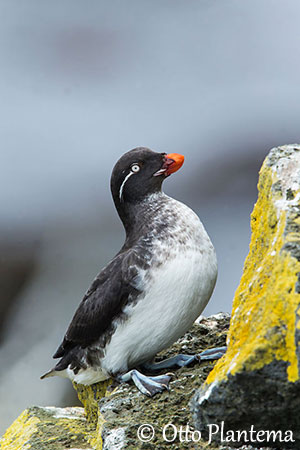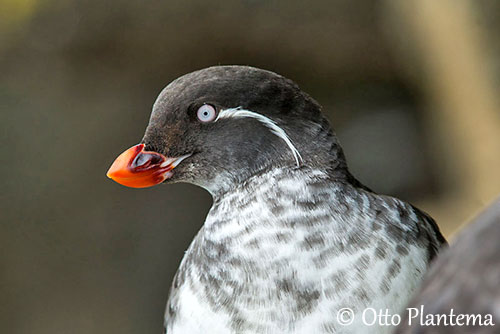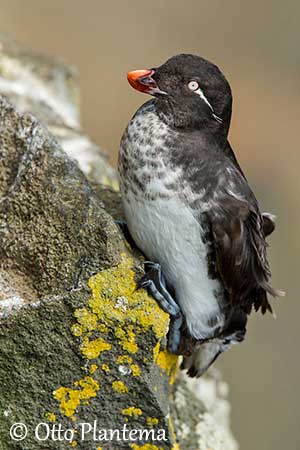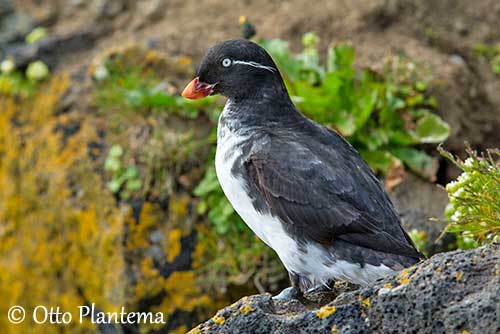Fr : Starique perroquet
Ang : Parakeet Auklet
All : Rotschnabelalk
Esp : Mérgulo Lorito
Ita : Alca minore pappagallo
Nd : Papegaaialk
Sd : Papegojalka
Russe : Белобрюшка
Photographer:
Otto Plantema
Trips around the world
Text by Nicole Bouglouan
Sources:
HANDBOOK OF THE BIRDS OF THE WORLD Vol 3 by Josep del Hoyo-Andrew Elliott-Jordi Sargatal - Lynx Edicions - ISBN : 8487334202
BirdLife International (BirdLife International)
Alaska Seabird Information Series
What Bird-The ultimate Bird Guide (Mitchell Waite)
Wikipedia, the free encyclopaedia
Parakeet Auklet
Aethia psittacula
Charadriiformes Order – Alcidae Family
INTRODUCTION:
The Parakeet Auklet was formerly included in the genus Cyclorrhynchus which refers to the nearly circular profile of the bill. But following recent phylogenetic study, this species could be a close relative of the Crested Auklet, Least Auklet and Whiskered Auklet.
Unlike other auklets, it does not form large breeding colonies. This species is highly vocal and duets are executed by both mates during pair formation.
Like numerous seabirds, the Parakeet Auklet is threatened by ingestion of plastic, mortality in fishing nets and oil pollution. Gulls and invasive predators are another threat at breeding colonies. Hunting and egg-collecting are still a threat in Alaska.
DESCRIPTION OF THE BIRD:
Biometrics:
Length: 23-25 cm
Weight: 295-300 g
The adult in breeding plumage has black upperparts, wings, tail, chin and throat. Rest of underparts is mostly white, with white mottled and barred blackish upper breast and body sides. The underwing is dark.
The head is sooty black with a white nuptial plume projecting back from the eye.
The distinctive bill is laterally compressed. The lower mandible is upturned, involving almost circular appearance. The gape is pale yellowish. The eyes are yellowish-white. Legs and webbed feet are bluish-grey, with darker webs and black claws.
Both sexes are similar.

During winter, the bill is smaller after losing the different horny plates. It is mostly dull brownish-red. The white nuptial plume is reduced or absent, and the throat is white.
The juvenile resembles adult in winter with smaller bill.
RANGE:
The Parakeet Auklet occurs from SE Alaska, through the Gulf of Alaska, in most of the Bering Sea and in Siberia in the Sea of Okhotsk. This species is locally present in SE Alaska and on the Kenai Peninsula. It is found on some islands in the Gulf of Alaska (Shumagin, Semidi and Chirikof Islands).
There are concentrations of this species in the Aleutian Islands and in the Bering Sea.
During winter, the Parakeet Auklet occurs at sea and along the coasts, at limit of open water but close to the breeding areas. It moves further south, from Bering Sea, S to N Japan and occasionally to S California.

HABITAT:
The Parakeet Auklet breeds on offshore islands, usually on steep sea cliffs and rocky slopes with some vegetation such as grasses and mosses. It may also breed on boulder fields with other auklet species, above the high-tide line.
During winter, some of them can be seen in ice-free areas within the breeding range, but most of them disperse S as far as Japan and California.

CALLS AND SONGS: SOUNDS BY XENO-CANTO
The Parakeet Auklet is usually silent, but during the breeding season, it becomes very vocal close to the nest-site.
A mated bird landing near the nest utters a trilled song until its mate arrived. Then, both partners perform a duet, usually short trills of less than 4 seconds.
The Parakeet Auklet also calls from perch with stretched neck, open bill and head tilted up briefly.
As this species is very vocal, several calls have unknown significance. But the vocal displays are used in threat display against rivals or intruders, and in social communication. From a recent study, five call types are recognized in adults, including 3-4 structurally diverse types of notes.
A small group of 10-25 birds at sea gives repeated series of pulsed trills, whereas disturbed birds produce a squealing note while taking flight.
BEHAVIOUR IN THE WILD:
The Parakeet Auklet feeds on jellyfish, krill, planktonic crustaceans and small fish.
This species is a food generalist, and during the nesting period, the chicks are fed with similar preys carried by both adults in their sublingual throat pouch.
The Parakeet Auklet forages by diving from the surface, and the prey is pursued underwater. It can dive to depths around 30 metres and during less than one minute.
It feeds throughout the year on planktonic crustaceans such as Calanus and Neocalanus (copepods), euphausiids and amphipods. It forages at variable distance from the breeding colony.
The Parakeet Auklet is monogamous. They breed in small colonies on offshore islands, often with other auk species. They are very faithful to nesting site and mate.
There is no information about the courtship displays of this species, but it becomes highly vocal during the breeding season. Both mates often perform duets. Courtship displays occur on land, whereas copulation takes place at sea.
The Parakeet Auklet disperses after breeding, from late August to early October. Some birds remain in open waters near their breeding sites (Pribilof, Aleutians), but most of them move southwards to spend the winter in oceanic waters as far as Japan and occasionally to S California. They return to the colonies in April-May, slightly later at northernmost locations (mid-May/mid-June).
This species has strong, direct flight.
REPRODUCTION OF THIS SPECIES:
The breeding season takes place in spring. The laying varies from south to north, with 4-5 weeks of difference between regions, usually through May and June.
The Parakeet Auklet breeds in smaller colonies than other auklets. The nest is placed deep inside dark rock crevices and cavities. It is unlined, or sometimes with small pebbles.
The female lays a single whitish egg, and both adults incubate during 35-36 days. At hatching, the chick has blackish-brown down above, paler below. The head is paler than back. Both parents feed and care for the chick until fledging, about 35-37 days after hatching. Then, the chick leaves the colony at night, and flies alone to the sea.
Eggs and chicks are preyed upon by voles.

PROTECTION / THREATS / STATUS:
The Parakeet Auklet is currently threatened by human disturbances and harvesting predation by invasive mammalian species, marine pollution, ingestion of small particles of plastic in N Pacific, and drowning in fishing nets.
The global population is estimated at about 1,200,000 individuals, and is suspected to be in decline due to the usual threats.
But currently, the Parakeet Auklet is evaluated as Least Concern.